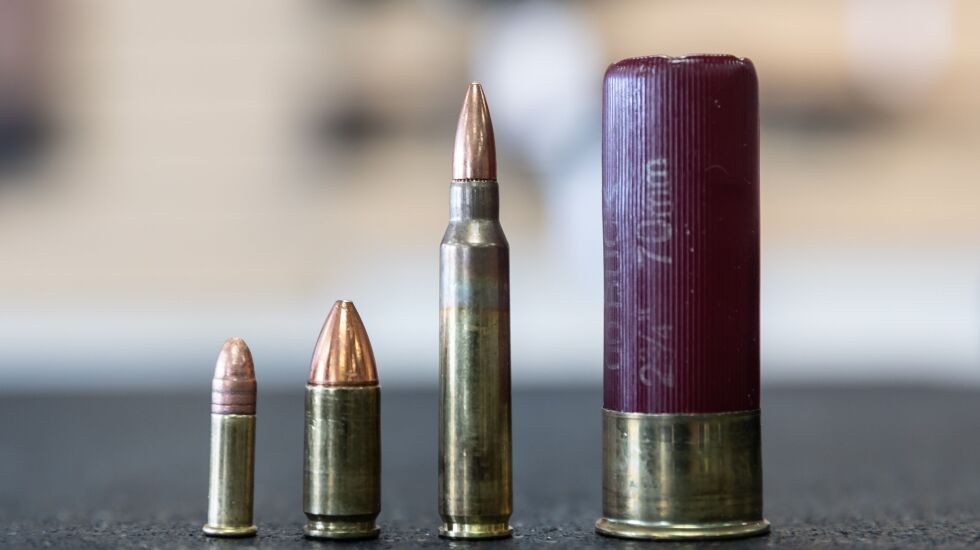
Small and mid-sized Illinois cities have surpassed Chicago’s gun homicide rate in recent years, mirroring a national trend, a new analysis of city-level firearm violence data found.
Magic Wade, a political science professor at the University of Illinois Springfield, studied firearm homicide and injury data from the Gun Violence Archive for small, mid-size and large cities nationwide from 2015 to 2021.
“There’s a cluster of cities in Illinois that have gun homicide rates that are actually higher than Chicago’s, or they’re close to it,” Wade said.
“What’s been a big change is in cities like Rockford and Peoria. Both of those cities went from having about 12 per 100,000 in 2015 to Rockford having 17 per 100,000 in 2020. And Peoria had nearly 25 per 100,000.” she said.
Wade also found that Champaign’s rate in 2021 was 18 gun homicides per 100,000 people in 2021, and Chicago’s rate was 15 per 100,000 people the same year.
She also found that 2019 was a turning point for elevated gun violence rates before the nationwide spikes in 2020 and 2021.
“The pandemic accelerated a trend that was already happening,” Wade said. “After 2019 and through 2021 average rates of fatal and non-fatal shootings only increased across all city-size groups. This shows a broad trend of increasing gun violence that started in 2019, accelerated in 2020 and continued in 2021.”
Wade’s analysis, published in the peer-reviewed journal Homicide Studies, also compared heightened gun violence in recent years to another period when the firearm death rate was high — the 1990s. And though larger cities haven’t hit records from that time, mid-sized and small cities are experiencing far more violence, Wade said.
“In the ’90s, it is absolutely true that in large cities, the homicide rate was much higher than it is today, even with these recent increases,” Wade said. “Now we’re seeing unprecedented amounts of gun violence in communities that never experienced it before or experienced very little.”
Her report finds that the number of U.S. cities reaching firearm homicide rates surpassing the peak gun homicide rate in 1993 has increased every year since 2015, with a 30% spike in fatal and non-fatal gun injuries in 2020 that worsened in 2021.
“The data shows that the problem is much more widespread than previously thought,” Wade said. “Gun violence is not merely a red state or blue city problem, it is a worsening phenomenon affecting American communities everywhere.”
Wade included small and mid-sized U.S. cities in her analysis to show that in many cases they have recently surpassed firearm homicide rates in larger metro areas.
“Urban gun violence gets viewed as a problem when it’s only in Chicago, in DC, in Philadelphia. There are lots of problems with doing that, and it makes it seem like gun violence is only a problem in big cities,” Wade said.
Firearm injuries are also high for smaller cities, Wade found in her research. For example, Springfield’s non-fatal injury rate was 34 per 100,000 people in 2020 and 46 per 100,000 people in 2021.
“Non-fatal gun violence in a community is really destabilizing. And that’s something that never gets shown in statistics at a national level, only mortality statistics are presented,” Wade said.
“If you take the non-fatal and fatal firearm injuries together, it paints a starker portrait of the amount of gun violence than taking the homicide statistics alone, which we’re more likely to hear about and more likely to care about.”
Other studies have examined the nationwide spike in gun violence during the COVID-19 pandemic — one found a 28% increase in firearm deaths and a 34% increase in firearm injuries from March 2020 to February 2021.
Another found that gun assaults on children roughly doubled during the pandemic in Chicago, Philadelphia, Los Angeles and New York.
Understanding the scope and severity of gun violence in all communities is key for identifying effective solutions and measuring what prevention efforts work, Wade said.
“That’s why this kind of longitudinal study is so important,” she said. “If we can identify where the trends are, where it’s getting worse or better, we can figure out what works to decrease violence.”







